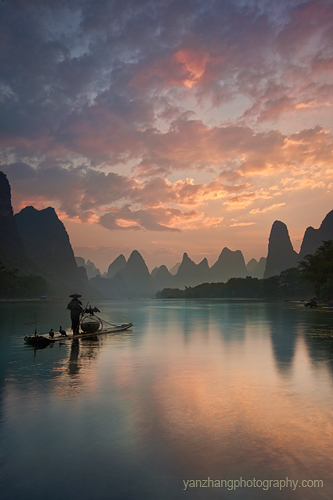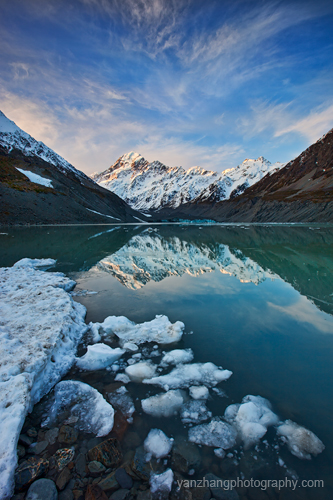For many years, Li River has been viewed as an iconic symbol of oriental beauty. It is one of those a few places of China that is so popular by attracting lots of tourists every year but still remains its natural purity.

Li River Sunrise
This photo was taken in Xingping County along Li River on 11 October 2011. The local photographer said that it was not an ideal time to make pictures of Li River from October to April of the next year because an overcast weather over Li River was very common during this period. But there was an exception this time. I was told that it had been continuously raining for an entire week but just stopped on that day when I arrived in Xingping. Then I knew I probably would be lucky enough to witness some beautiful sunrise and sunset moments during my this trip. Indeed, on the third day, I encountered a spectacular sunrise over the beautiful Li River.
The image was taken with my Canon 5D Mark II camera and 16-35mm f/2.8L II lens. I used tripod Gitzo GT2531EX CF6X Explorer 2 (BH-55 Ballhead) to support the camera and lens, and a RC-1 canon remote release to trigger the shutter.
To balance the light between the sky and foreground (river), a Lee .6 GND soft filter and a Lee .3 GND hard were used. I found that this filter combination provided the best effect without causing any visible grey line between the water and mountains.
This image was also a result from blending three successive shots within 15 minutes. When the sky was getting to dance, I made a shot with aperture f/22, focal length 29mm, ISO 50 and shutter speed 20 seconds. This long exposure made the river have a peaceful and tranquil feeling, where the cloud reflection was also showed in the water. Soon after this shot, I found the clouds became even more dramatic, so I made the second shot focusing on the sky with aperture f/10, focal length 29mm, ISO 100 and shutter speed 1.3 second. Then a few minutes later, something interesting happened: a fisherman suddenly rowed into my frame – this was completely out of my expectation! I quickly made the third shot: aperture f/8.0, focal length 29mm, ISO 100 and shutter speed 1/13 second.
The first two shots were well planned, but the third shot was by chance, which eventually played the most significant role to produce the final image.
I opened three images raw files in Camera Raw 6.3, made a small adjustment for each of these files by just filling a bit light for the first two images increasing both clarity and vibrance to 12. Then I loaded them into Photoshop CS5.
In Photoshop CS5, I first blended the first two images together: the intermediate resulting image combined the first image’s water reflection (lower part) and the rest parts of the second image. Then I further blended this intermediate resulting image with the third image by carefully painting the fisherman and the associated water reflection into the earlier combined image. In this step, localizing the fisherman and his reflection was critical. Paint opacity should be not more than 5%, and gradually painting was carried on until the fisherman (reflection) smoothly appearing and merged with the rest part of the image.
After three images were carefully merged, a standard Photoshop processing was carried out. As an additional yet important stage, I further applied Tony Kuper’s mask luminosity technique to select “Expended Mid-tones Pixels” in Channels, and then select Curve to create a Curve layer. By adjusting this curve I could further enhance the contrast on expended mid-tones pixels, which made the overall image pop out nicely.
I was satisfied with the final image after processing. I think blending three images together was an important step to make an image illustrating such a beautiful scene of Li River that I have had in my mind for a long time.
On that day early morning, I traveled by a small boat for one hour to get to this location when the sky was still very dark, so I had plenty of time to set up my tripod and considered various compositions. From the dawn to sunrise, the light changed dramatically, and also local people started to work on their boats in the river. Under this situation, the first shot was critical to capture the stillness of the water when no one was there. To me, the impressive sky and its reflection in the water were the primary feature I wanted to capture, while the unexpected fisherman captured in the third shot just added an exceptional highlight to this image.
Overall, I believe that the following three things are important to make a good landscape photograph:
– Persistence. If you find a wonderful place to photograph, you probably have to visit there many times. In the last five years, I visited Xingping four times, and went to this specific location seven times. Only this last time I got the wonderful light. Visiting Li River also meant that I have to travel far enough each time (from Australia to China).
– Patience. In that morning, I thought I already made the best photos after the first two shots, while two photographers nearby started to move to another location. Luckily, I stood there a bit longer without moving my tripod, so that I could capture the third image with the fisherman coming to the right spot with the same composition.
– Always try different compositions if you have time. I believe that this is quite critical to achieve the best outcome. In that morning, after I made these three shots, I also took several landscape-oriented shots. It appeared to me that both compositions were equally impressive.
Visit Yan Zhang Photography for more images.



